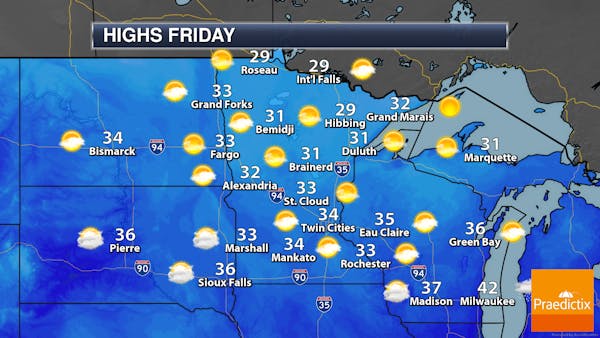Minnesotans from every corner of the state might have a chance at seeing the northern lights Thursday night into early Friday morning — and up north, they could cover half the night sky.
The National Weather Service is predicting mostly clear skies throughout the state Thursday night, with some scattered clouds in northern Minnesota, giving hopeful stargazers a better chance at observing the natural light display.
The northern lights, or aurora borealis, occur when charged particles are expelled from the sun and collide with gases in the Earth's upper atmosphere. Billions of little flashes are the result, filling the sky with colorful and dancing lights.
By far the best way to catch the northern lights is by simply heading north, said "Astro" Bob King, who writes an astronomy column for the Duluth News-Tribune and plans to publish a guide to the phenomenon next year.
From midnight to 3 a.m. Friday, the National Oceanic and Atmospheric Administration (NOAA) is predicting the peak of a strong geomagnetic storm, or a G3 on its scale from G1 to G5.
With a G3, northern Minnesota would see the lights take up the northern sky and tip into the south as well, King said. And from the Twin Cities, you could get a good view once you leave the metro area's light pollution bubble.
NOAA offers similar advice for viewing the aurora. The magnetic pole is located in the islands of northeast Canada, and given the right vantage point — such as a hill with a clear view toward the north — a person might see the lights from 600 miles away, according to its website.
For those in the Twin Cities, King recommends taking Interstate 35 to Hinckley, leaving the freeway and finding a low-traffic dirt road with a north-facing view of the night sky. Pull over only where it feels safe and bring a friend along, he said.
Finding a good location to view the lights from the south metro is a little different, King said. He suggests heading in the direction of towns like Litchfield, Minn., or into Wisconsin.
"The main thing is just putting all of that light well off to one side, or in your rearview mirror," he said.
A handy guide for navigating around light pollution is this interactive map, King said, where users can view the levels of light pollution around the world. Some of the clearest skies in Minnesota can be found in northern counties like Beltrami, Koochiching, Lake and Cook.
"Go to the bluest area you can find," he said. "Mostly, you want to be sure that to the north, there are no large towns, no cities."
Around Duluth, King suggests locations like the dog park in the north part of the city, or past the first big tunnel on Hwy. 61 north of Two Harbors for a northeast-facing view of Lake Superior.
Identifying the lights can be tricky, especially due to their unreliable timing, King said. One way to determine if the hazy glow in the distance is really the northern lights is by taking a picture with a smartphone or digital SLR camera. If you see green and an arc-like shape, you've found them.
But King stresses that the forecast is not set in stone. He's seen the lights start in late afternoon and wind down by early evening.
"Or worse — it might happen at sunrise," he said.
King said he has a good feeling this time because there are multiple blasts from the sun all arriving at around the same time.
Another consideration for tonight is the waning gibbous moon that will rise at 7:15 p.m., mixing with the light display.
"That's going to take away some of the grandeur. But if it really does become a strong storm, the storm will outdo the moon, no problem," King said.
Carolyn Parnell, 'trailblazer' who served as Minnesota's first IT commissioner, dies


